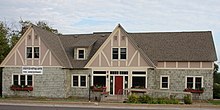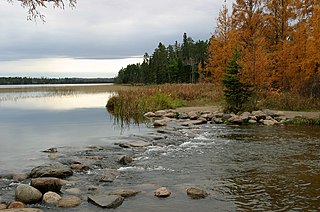
Itasca State Park is a state park of Minnesota, United States, and contains the headwaters of the Mississippi River. The park spans 32,690 acres (132.3 km2) of northern Minnesota, and is located about 21 miles (34 km) north of Park Rapids, Minnesota and 25 miles (40 km) from Bagley, Minnesota. The park is part of Minnesota's Pine Moraines and Outwash Plains Ecological Subsection and is contained within Clearwater, Hubbard, and Becker counties.

Split Rock Lighthouse State Park is a state park of Minnesota on the North Shore of Lake Superior. It is best known for the picturesque Split Rock Lighthouse, one of the most photographed lighthouses in the United States. Built by the United States Lighthouse Service in 1910, the lighthouse and some adjacent buildings have been restored and the Minnesota Historical Society operates them as a museum. The 2,200-acre (890 ha) state park offers a unique cart-in campground and scenic trails for hiking, cross-country skiing, and bicycling.
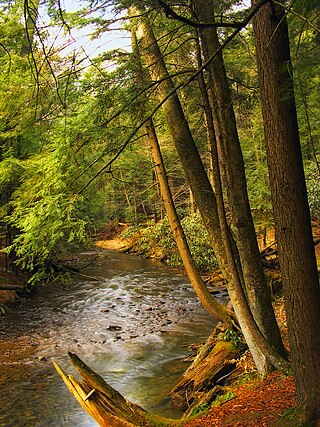
Cook Forest State Park is a 8,500-acre (3,440 ha) Pennsylvania state park in Farmington Township, Clarion County, Barnett Township, Forest County and Barnett Township, Jefferson County, Pennsylvania in the United States. Located just south of the Allegheny National Forest, the park is a heavily wooded area of rolling hills and mountains along the Clarion River in northwestern Pennsylvania. Cook Forest State Park is known for some of America's finest virgin white pine and hemlock timber stands and was once called the "Black Forest" due to the preponderance of evergreen tree coverage.

Judge C. R. Magney State Park is a state park in the U.S. state of Minnesota, on the North Shore of Lake Superior. It was named for Clarence R. Magney, a former mayor of Duluth and justice of the Minnesota Supreme Court, who was instrumental in getting 11 state parks and scenic waysides established along the North Shore. The park is best known for the Devil's Kettle, an unusual waterfall and rock formation in which half of the Brule River disappears into a pothole.
Almelund is an unincorporated community in Amador Township, Chisago County, Minnesota, United States.
Kabetogama is an unincorporated community in Kabetogama Township, Saint Louis County, Minnesota, United States, located within the Kabetogama State Forest.
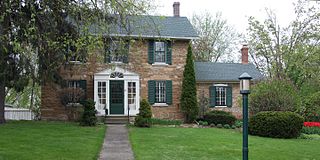
The Frederick Spangenberg House is a historic house in Saint Paul, Minnesota, United States. It was built from 1864 to 1867 as the residence of a farm in what was then rural land outside the urban center. The house was listed on the National Register of Historic Places in 1976 for having local significance in the theme of architecture. Now enveloped by a 20th-century residential neighborhood, it was nominated for being one of the oldest limestone farmhouses preserved in Saint Paul.

Schroeder is an unincorporated community in Schroeder Township, Cook County, Minnesota, United States.

The Old Faithful Historic District in Yellowstone National Park comprises the built-up portion of the Upper Geyser Basin surrounding the Old Faithful Inn and Old Faithful Geyser. It includes the Old Faithful Inn, designed by Robert Reamer and is itself a National Historic Landmark, the upper and lower Hamilton's Stores, the Old Faithful Lodge, designed by Gilbert Stanley Underwood, the Old Faithful Snow Lodge, and a variety of supporting buildings. The Old Faithful Historic District itself lies on the 140-mile Grand Loop Road Historic District.

Mara Lake is a lake in the Shuswap Country region of south central British Columbia, Canada. To the west is Hyde Mountain and east is Morton Peak. The outlet of the Shuswap River forms the upper reaches. The lower end enters the narrows at Sicamous and flows into Shuswap Lake. The northern end of Mara Lake is by road about 73 kilometres (45 mi) west of Revelstoke, 140 kilometres (87 mi) east of Kamloops, and 75 kilometres (47 mi) north of Vernon.

The Mille Lacs Indian Museum and Trading Post is a museum dedicated to the Mille Lacs Band of Ojibwe's history, culture, and contemporary life. It officially opened to the public on May 18, 1996. Located in Onamia, Minnesota, United States, it is one of the 26 historical sites and museums run by the Minnesota Historical Society.

The James Cant Ranch is a pioneer ranch complex in Grant County in eastern Oregon, United States. The ranch is located on both sides of the John Day River in the John Day Fossil Beds National Monument. The ranch was originally homesteaded by Floyd Officer in 1890. Officer sold the property to James Cant in 1910. Cant increased the size of the property and built a modern ranch complex on the west bank of the river. The National Park Service bought the ranch from the Cant family in 1975, and incorporated the property into the John Day Fossil Beds National Monument. The National Park Service used the main house as a visitor center until 2003. Today, the Cant Ranch complex is preserved as an interpretive site showing visitors an early 20th-century livestock ranch. The James Cant Ranch is listed on the National Register of Historic Places.

Katepwa is a resort village in the Canadian province of Saskatchewan within Census Division No. 6. It is on the eastern and southern shores of Katepwa Lake in the Rural Municipality of Abernethy No. 186. The name Katepwa likely comes from the Cree word Kahtapwao meaning "What is calling?" The name was given to the last in the chain of four lakes, Katepwa Lake. Legend has it that spirits inhabited the shores of the lake and First Nation people would hear voices on the lake.
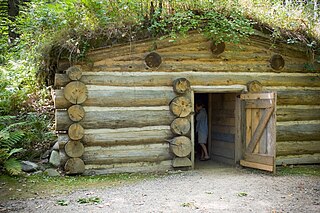
The Forest History Center is part of the Minnesota Historical Society's network of historic sites and museums. Located in Grand Rapids, Itasca County, Minnesota, on wooded acreage adjoining the Mississippi River, the Forest History Center provides learning experiences about the forests, logging industry, and forest conservation. The historical and changing relationship between the people and the forest is displayed through exhibits and films, demonstrations, a living history lumber camp, an original 1934 fire tower, and nature trails. The Forest History Center has regular special events, and offers various programs for school field trips.

The Banfill Tavern, also known as the Locke House, is a historic building in Fridley, Minnesota, United States. It was built in 1847 on the east bank of the Mississippi River and has served variously as an inn, a logging camp office, a private home, a dairy farm, a post office, and a summer home. It is now owned by Anoka County and, until April 2022, housed the non-profit Banfill-Locke Center for the Arts. The building stands within Manomin County Park, and the art center is a partner site of the Mississippi National River and Recreation Area.

Loon Lake is a hamlet and a lake in the northeastern region of Adirondack Park in the U.S. state of New York. The community is located on the east side of Loon Lake and 18 miles (29 km) northeast of Saranac Lake and 27 miles (43 km) north of Lake Placid.
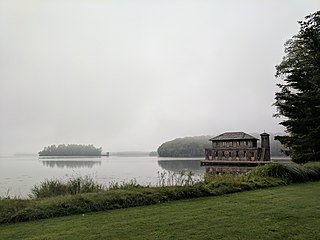
Forest Lodge is a hunting and vacation retreat of the Livingston/Griggs family on the shore of Lake Namekagon within the town of Namakagon, Wisconsin. The complex consists of 16 rustic structures built from 1893 to about 1950. Since 1999 it has been managed by the Chequamegon-Nicolet National Forest. It was added to the National Register of Historic Places in 2002.
The W. D. Boyce Council of the Boy Scouts of America serves youth in central Illinois, from Lincoln to Ottawa, and Peoria to Bloomington.

Kelly's Camp is a small district of vacation cabins on the west shore of Lake McDonald in Glacier National Park, Montana, USA. Kelly's Camp consists of twelve log buildings along the western shore of the lake. The structures were notable for being one of the most extensive summer cabin enclaves remaining in the park. Early reports following the advance of the Howe Ridge Fire on August 12, 2018 are that nine or ten structures have been destroyed.
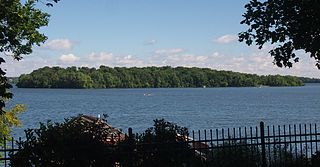
Coney Island of the West is an island in Lake Waconia in the U.S. state of Minnesota that was developed into a summer resort with its heyday from the 1880s to the 1920s. It continued operating up to 1960. The 31-acre (13 ha) island is part of Waconia Township just .5 miles (0.80 km) off the shore from the city of Waconia. It was listed on the National Register of Historic Places in 1976 for its local significance in the themes of commerce and entertainment/recreation. The island site, with its ruins of hotels, cottages, and parks, was nominated for being one of Minnesota's most popular early resorts, and an early expression of the trend of urban dwellers journeying to Minnesota's lakes and parks for recreation. Lambert Naegele, Reinhold Zeglin, and Emile Amblard developed resort buildings and attractions on the island. The best preserved building from this era, however, is the Emile Amblard Guest House on the mainland.
